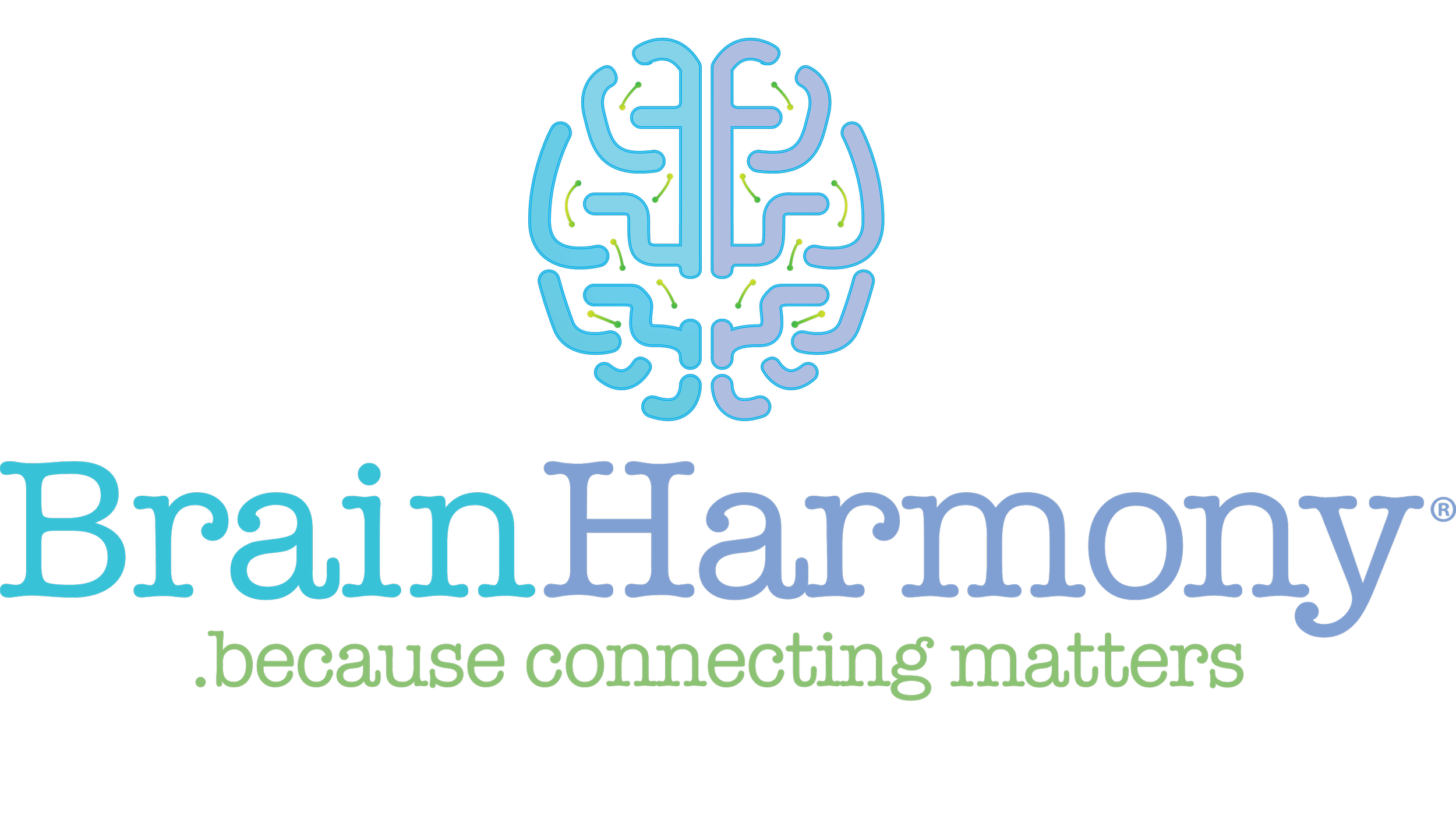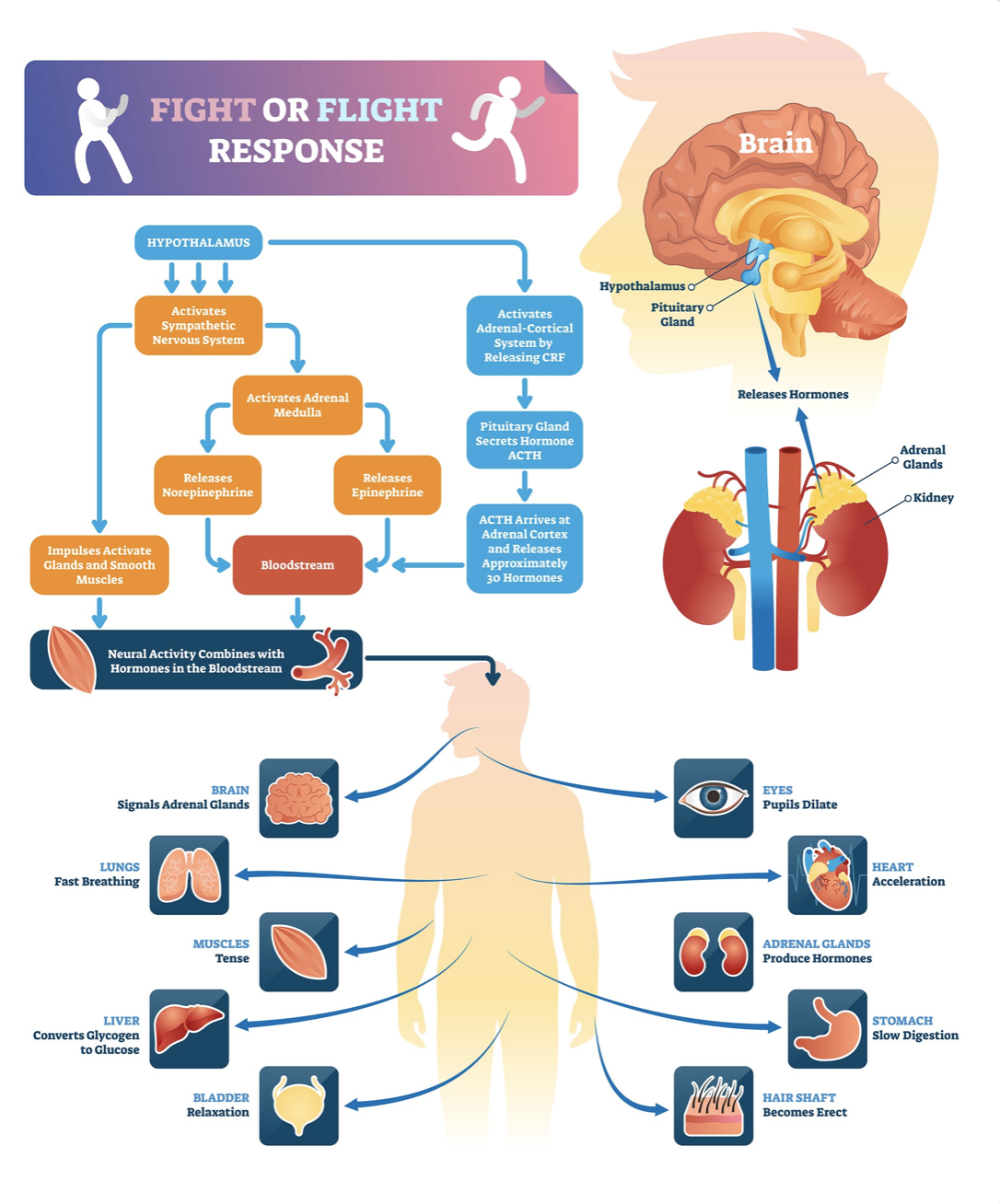Fight, Flight, Freeze, or Fawn Within Trauma
You've likely heard of "fight or flight" activation, which is an automatic response triggered by the presence of an immediate potential threat or danger. The freeze or fawn (previously called “fold”) activation response is a bit newer, within its research, and it has emerged as a new way to understand the history of our threat detection systems. Today we’re going to talk about all four in relation to Trauma.
Both adults and children come to Brain Harmony for many reasons (we treat over 40 conditions), but one of the most prominent is Trauma, such as sexual assault and the impact of intimacy and the healing process for the survivor. Of course there are many types of trauma, and we treat all of these with equal attention and approach to healing. The common aftermath, whether it’s a sudden event that’s taken place, or a series of events over time, are overwhelm, shutdown, disassociation, and/or being disconnected from partners in the present, because of the intrusive thoughts of the trauma in the past - and these are all elements of fight, flight, freeze or fawn.
First and foremost, we need to make sure that you or your loved one have been removed from the particular trauma threat and situation to prevent it from happening again, before we can start treatment, or that you are able to get to a place away from that trauma where you can begin your healing process with our protocol. This is because we need to make sure that your neurological system can be reset, and be capable of the changes we will be enacting.
Our approach is unlike cognitive or talk therapy, where you sit with someone, talk about the past and present, and discuss how to cope with the symptoms of reoccurring, unresolved trauma. We also do not use chemicals to compensate for the symptoms of unresolved trauma, as these chemicals do not change the brain or nervous system responses, which is what we need to do to make a lasting difference. In addition, using pharmaceuticals often cause side effects that make healing even more difficult - everything from brain fog to mental health deterioration like anxiety, depression, and auditory processing disorder, to intimacy distortions and misreads, and other physical and mental symptoms.
Instead, at Brain Harmony, our approach is to heal from trauma through the use of unique intrinsic mediums like sound, music, alpha waves and vibration that focus on vagal regulation, under the direction and care of our specialized therapists.
By understanding the intricacies of your autonomic nervous system, and the triggers that push it in one direction or another, you may be better able to get a handle on the stressors and events in your life that feel overwhelming or unmanageable.
In this article, we'll cover:
What your autonomic nervous system is
The historical view of the fight or flight response
What we’ve learned about "freeze or fawn” (sometimes called “freeze or fold”)
How to get yourself out of a state of feeling hijacked by your ANS and back into a place of safety and calm, using our specialized protocols
What Is The Autonomic Nervous System (ANS)?
Your autonomic nervous system (ANS) is the branch of your nervous system that's responsible for all the processes that go on just below your conscious awareness. For instance, when you eat a meal, you don't have to willfully think about how your body will digest and absorb it or continually focus on taking in oxygen through your lungs all day. These are processes that happen without any conscious input from you, and instead are carried out through the direction of your ANS.
Some of the vital functions that your ANS is responsible for include[*]:
Blood pressure
Heart and breathing rates
Body temperature
Digestion
Metabolism (thus affecting body weight)
The balance of water and electrolytes (such as sodium and calcium)
The production of body fluids (saliva, sweat, and tears)
Urination
Defecation
Sexual response
Along with the crucial subconscious activities that are regulated by your ANS, from an ancestral perspective, this system is also responsible for your feelings of safety and survival.
The ANS has two primary divisions that regulate its function, the sympathetic branch, and the parasympathetic branch. However, recent understanding into the ANS has uncovered subtleties that bridge these two branches, along with a third activated state called dorsal vagal shutdown.
The traditional understanding of the autonomic nervous system goes something like this:
Parasympathetic Mode
When you feel safe and calm, and there is no threat in sight, your ANS goes into parasympathetic mode. In parasympathetic mode, your heart rate will slow, breathing becomes deep and relaxed, digestion is engaged, and your sexual response is more active. This is a time to relax and enjoy what life has to offer.
Sympathetic Mode
On the other hand, when you sense a threat in your environment, your sympathetic mode is engaged. Your body responds by enhancing your heart rate, and breathing, digestive functions, and sexual arousal take the back burner, and you enter what is known as the "fight or flight” response.
A New Take On The Autonomic Nervous System
As previously mentioned, more recent discoveries are finding that your ANS is a bit more complex than we once believed. While parasympathetic mode continues to be the primary state when you feel safe and calm, there is much more to the story when stress enters the scene.
Instead of a fight or flight response that's tied to sympathetic mode, researchers have found that there is an additional response, called "freeze or fawn" or “freeze or fold” that acts as a secondary adaptation to situations that our subconscious deems dangerous. This offers us a deeper understanding of how trauma may affect the responses of the autonomic nervous system, and therefore our actions and behaviors when we feel unsafe.
When the "freeze or fold" response is activated, you're no longer operating solely from the sympathetic branch but engaging something called dorsal vagal activation.
Dorsal Vagal Activation
Dorsal vagal activation is triggered when the perceived threat moves from "dangerous" to potentially life-threatening. This ancient defense system creates a shift in your ANS that largely influences organs below your diaphragm. It drops your metabolic rate, immobilizes your body, and shifts you into a state of numbness, shutdown, and collapse.
In dorsal vagal activation, your body begins to release its natural pain killers known as endogenous opiates that bring a sense of calm in the face of anticipated death. This mode of your ANS is actually the oldest evolutionary defense system.
Fight, Flight, Freeze, Or Fawn
With the incorporation of dorsal vagal mode, we can now look at our defense system with more insight. The four evolutionary states brought on by stress or danger include:
Fight
The "fight" response is controlled by the sympathetic nervous system. This is in line with the traditionally understood adaptation for a human to kick their survival instincts into high-gear in the face of danger.
In the fight response, your heart rate will increase, breathing will become heavier, and your blood will move from your internal organs to your limbs so you can fight off your predator and protect yourself. Emotionally, when you're in fight mode, you can be angry, irritated, and rageful.
Flight
In the "flight" response, your body will shift into sympathetic mode much the same as "fight." The major difference here is that instead of anger being your driving emotion, fear will take the reigns along with worry, anxiety, and sometimes even terror.
In flight, you aren't interested in fighting off the danger; you want to avoid and flee the scene.
Graphic below shared from Simply Psychology
Freeze (enter: dorsal vagal activation)
The freeze response is a hybrid between sympathetic mode and dorsal vagal activation. This is where the latest research is beginning to stray from the classic sympathetic vs. parasympathetic model.
In freeze, your body is activated by both sympathetic and dorsal vagal mode. While fear is still a driving emotion, the desire to run or fight is overshadowed by a sense of immobilization coming from dorsal vagal activation. It can be somewhat confusing when you see someone in freeze mode because their lack of outward aggression or anxiety may lead you to believe that they are calm, when in fact, they are simply just numb[*].
Fawn (full dorsal vagal shutdown)
In fawn mode, you are immediately acting to try to avoid any conflict. When the fawn response is activated, you have exited sympathetic mode and entered complete dorsal vagal shutdown. You are no longer looking for ways to survive (fight or flight) and instead enter a state of physical and emotional collapse.
In this state of overwhelm, you may experience absent-mindedness, dissociation, and depersonalization. In extreme cases, you may even pass out or lose consciousness. But unfortunately the “please and appease” part of ourselves sometimes can keep us in the trauma bond of a family or relationship, despite these extreme and dangerous reactions. Which again leads us to remind you that if you can, we ask you to find a way out of your trauma situations if you are still in them, because this state can persist as long as we are in the presence of those triggers. However, if you are not able to leave, or have persistent triggers even when you are not in their presence, you can still build neurological resilancy to shift out of these states with conscious control.
Implications Of Chronic Trauma
Your body has the ability to move in and out of parasympathetic mode, sympathetic mode, and even dorsal vagal shut down with relative ease. In your daily life, you may experience moments of these states before your body self regulates and brings you back into a place of calm.
However, if you are under chronic stress or have experienced trauma, you can get stuck in sympathetic fight or flight or dorsal vagal freeze and fold. When this happens, it can lead to disruptions in everything from basic life skills like sleeping, self-care and eating, to complexities like learning and self-soothing. Furthermore, it can leave you in a state of anxiousness and depression, feeling withdrawn from life.
How Brain Harmony Can Help
At Brain Harmony, we see many friends come in with many states of vagal dysregulation that are either in sympathetic mode or dorsal vagal activation. Instead of offering quick-fix treatments like medications, we work with you from a bottom-up approach to get your nervous system back online and gently nudge you back into a state of calm and safety.
Our CALM™ approach begins with comforting the nervous system via the vagus nerve. With vagal regulation, we offer your brain a way to feel comfortable and safe as the vagus nerve is activated when you're in parasympathetic mode. It's only from this place that you can begin to reorganize the neural programming that got you into a state of "fight or flight" or "freeze or fold" in the first place.
At Brain Harmony, vagal regulation can involve a program called the Safe and Sound Protocol (SSP). The SSP is a listening program that offers music with sound that can travel through your tympanic membrane (eardrum) in your ear and reach the vagus nerve. From here, this input can regulate all kinds of autonomic responses like heart rate, breathing, digestion, and so on.
When you build up strength in your vagus nerve by listening to the Safe and Sound Protocol (SSP), you become more resilient to stress and begin to feel safer in your surroundings. In this way, regulation of the vagus nerve is the ultimate way to enhance your mind-body connection. It’s truly a wonderful tool, although not all clients are candidates for the SSP, so be sure to take our quiz and schedule a consult to learn more.
Another tool that we use to enhance feelings of safety and calm is the Alpha-Stim. The Alpha-Stim device is attached to your earlobes and generates a patented alpha waveform that works on a cellular level by enhancing alpha waves in your brain. Alpha waves create a sense of calm as they relieve anxiety, depression, and insomnia -- giving your nervous system a much-needed break from the hectic input of the modern world. It can truly change your quality of life.
Once you feel neurologically safe, then you are more prepared for the deeper organization to come. We can teach your brain new ways of responding to stress and other stimuli, training your brain to build new, healthier connections.
Kirks’ Brain Harmony Story
Growing up with complex trauma, Kirk had extreme difficulties with communication, anxiety, and managing everyday tasks. After discovering Brain Harmony’s protocols, Kirk was excited about the prospect of a program that has actually helped those who were nonverbal their whole lives, begin to speak. He began the Safe and Sound Protocol and soon realized it would allow him to unlock the life he had always imagined for himself.
“Growing up with complex trauma is just beyond any ability to communicate, and especially in the past few months, I’m comfortable enough with myself that I don’t mind another person seeing whatever happens to come up in the course of a conversation, and that would have almost been science fiction to me a couple of years ago.”
Nancy's Brain Harmony Success Story
Nancy had work-induced trauma stemming from her work as a nurse in an intensive care unit during the pandemic. She was struggling with anxiety, brain fog, and depression and was trying to find a non-pharmaceutical route. Nancy found that her brain fog and anxiety were getting in the way of work. She couldn't process her thoughts or get them down on paper, word retrieval was an issue, and she experienced memory loss. On top of it all, she felt depressed and disengaged with life.
Nancy needed help, and she felt that her meds weren't working, so she sought out another type of treatment and found Brain Harmony. After beginning the program, she noticed right away that her anxiety diminished using the Safe and Sound Protocol and Alpha-Stim. She then gradually felt the depression and brain fog begin to lift. She went from not being able to organize her thoughts to fully functioning at work and in life. Brain Harmony not only helped to heal her anxiety, but it lifted her brain fog, diminished her depression, and improved her sleep.
Here is a story about how we use the knowledge of vagal regulation to first give that pulse of safety to the nervous system that then awakens the portal of social engagement, which for Natalia was gaining access to speech and language skills.
Natalia's Brain Harmony Success Story
Natalia is on the more severe end of the autism spectrum and suffers from extreme general and separation anxiety, along with sleep issues and communication problems. For several years, Natalia's mother worked with speech therapists and occupational therapists to help Natalia.
Finally, Natalia's mother found Brain Harmony and got her started on the Safe and Sound Protocol. From Natalia's mother:
"I used it for just a month or so, but I see stuff in my daughter I have never seen. The anxiety disappeared, the sleeping got better. She's more calm. She said, "Mommy, you go to the store, I'll stay with Dad." She started to learn from other kids. She started to learn from her environment. She's starting to listen more. Some people told me that she will reach a cap and will never be able to be conversational. My daughter now goes to the park and talks to the kids."
How to Get Started
Reregulating the ANS response following trauma can take some time even with the most powerful tools to do so. You should expect 4-5 months of input before a strong regulated system can be built. The more layers of complexity, the longer the time to reset, but the groundbreaking bottom line is that we actually RESET THE NERVOUS SYSTEM in the first place so the commitment can be life-changing for trauma survivors. Take our Quiz and then schedule a free consult so that we can get started on healing your trauma.






